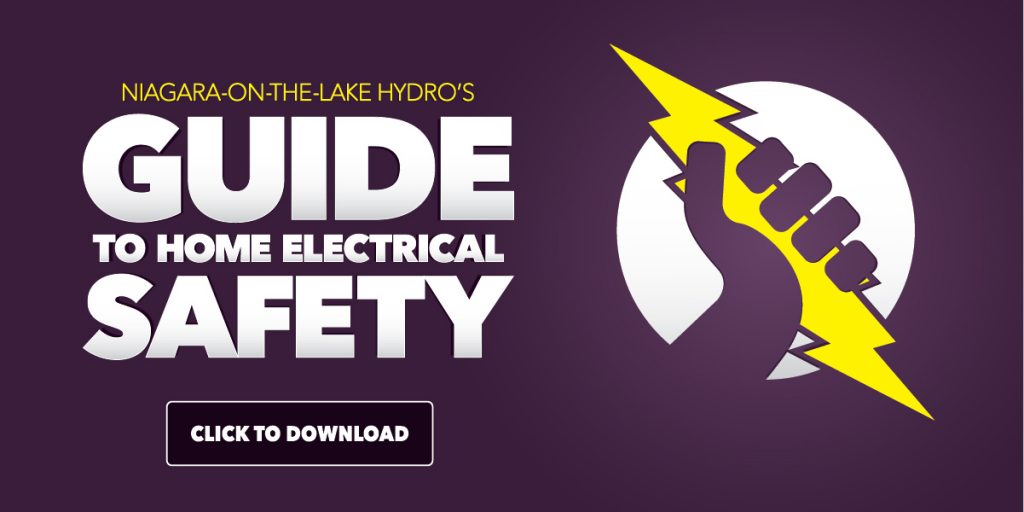Our highest value as a company is to not compromise on health & safety. That passion has resulted in the creation of a simple guide going over electricity fundamentals of safety at home, outside and powerline safety.
Important Items
- ESA Recall Notices – Updated regularly
- When doing any electrical work at home, ensure that you cut power to the fixture via your panel.
- Check all electrical fixtures to ensure that they bear the mark of a recognized certification agency.
![]()
- The Electrical Safety Authority recommends the use of a licensed electrical contractor or electrician for electrical work in your home.
The Right Tools
There are several tools that you should have if you’re doing any electrical work at home.

- Wire Stripper
Using a wire stripper (over a utility knife or pliers) lowers your chance of damaging the conducting wire. A damaged wire can cause short circuits and fires, which is generally considered a bad thing. - Outlet & GFCI Tester
Receptacle testers will let you know if you’ve wired a power outlet correctly. If it’s not done right, it’ll tell you what’s wrong using the built-in LED lights. Spend a few extra dollars for a GFCI version so you can test GFCI outlets. - Non-Contact Voltage Tester
You’re about to cut a wire that you think is de-energized, but is it? This tool will tell you if it’s on or off. Just place the detection end on to a wire or near an outlet. If the wire/outlet is hot (energized), it will beep. - Head Lamp
After de-energizing a room, you’ll often have to deal with lower light levels. Flashlights are nice but you’ll probably be safer using both of your hands. Head lamps help focus light on where you need it the most.
Installing New Outlets and/or Switches
- Caution: Outlets may be connected to two different circuits of your home’s electrical wiring system – test both outlet connections prior to proceeding with any electrical work.
- Outlets and switches must have proper cover plates that are in good condition to protect you and your family.
- Loose outlets and switches should be repaired.
- Outlets and switches that are warm to the touch, or hot, should be turned off immediately – and you should contact a licensed electrical contractor or electrician about this situation.
- Never force a plug into an outlet if it does not fit – and never remove the third prong from a plug to allow it to fit into an outlet.
Ground Fault Circuit Interrupters (GFCI)
- What they are: A Ground Fault Circuit Interrupter (GFCI) is an over current protection device designed to interrupt the electricity circuit to the load when a current to ground exceeds a predetermined value. GFCIs are designed to almost instantly sense an electrical ground fault and interrupt the protected circuit to stop the flow of electrical current before someone is hurt.
-
- In Ontario GFCIs are required for exterior outlets, bathroom outlets, and in new kitchen construction/renovation where kitchen counter receptacles/outlets are being installed within 1 meter of the edge of the kitchen sink.
GFCIs should be tested monthly to ensure that they are in proper operating condition. To test your GFCI you should:
- push the “reset” button on the GFCI.
- plug in a light or small appliance (turn on).
- push the “test” button – the light or small appliance should turn off.
- push the “reset” button – the light or small appliance should turn on.
If your GFCI does not function as outlined above you should contact a licensed electrical contractor or electrician to check and fix the GFCI.
Electrical Panels
- Electricity enters your home from the Local Distribution Company through the service entrance at the main switch. From the main switch, the panel board or fuse box splits power into circuits that distribute electricity throughout your home. Each circuit distributing power throughout your home is protected by a fuse or circuit breaker. Fuses and circuit breakers detect short circuits and overloading and will blow (fuse) or trip (circuit breaker).
- Modifications to your electrical panel should be done by a licensed electrical contractor or electrician and should be inspected by the Electrical Safety Authority.
- Fuses that regularly blow or circuit breakers that regularly trip should be checked by a licensed electrical contractor or electrician.
- Upgrades to your panel to increase service size (amperage) should be done by a licensed electrical contractor or electrician, and should be inspected by the Electrical Safety Authority.
Circuit Breakers and Fuses
- Fuses and circuit breakers are safety devices in your electrical panel that are designed to prevent overloading and potential fire hazards in your home. These devices protect against over current or overloading by stopping the flow of electricity when it exceeds safe levels for your home.
- Circuit breakers can be reset using hand controls after the problem has been eliminated.
- Fuses, once they blow, need to be replaced. It is important that you replace fuses with the proper size fuse. Also check to ensure that you are using the correct fuse. There are two types of fuses. Fuses identified with the letter “P” are recommended on all general circuits. Fuses identified with the letter “D” are time delay or dual element fuses and should only be used for large motorized appliances such as dryers, furnaces, refrigerators, freezers and window air conditioners. Fuses identified with the letter “D” should not be used on general lighting circuits.
